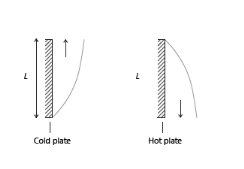All material properties are evaluated at (T + Text) ⁄ 2, except
ρs, which is evaluated at the wall temperature,
T, and
g is the acceleration of gravity equal to 9.81 m/s
2. This correlation is valid for
104≤ RaL ≤ 1013.
where the length of the wall, L, is a correlation input and

is the tilt angle (the angle between the wall and the vertical direction;

for vertical walls). These correlations are valid for
−60°
<  <
< 60° and
104≤ RaL ≤ 1013.
The definition of the Raleigh number, RaL, is analogous to the one for vertical walls and is given by the following:
g denotes the gravitational acceleration, equal to 9.81 m/s
2.
For turbulent flow, 1 is used instead of
cos 
in the expression for
h, because this gives better accuracy (see
Ref. 40).
The laminar-turbulent transition depends on 
(see
Ref. 40). Unfortunately, little data is available about transition. There is some data available in
Ref. 40 but this data is only approximate, according to the authors. In addition, data is only provided for water (
Pr around 6). For this reason, the flow is defined as turbulent, independently of the

value, when
All material properties are evaluated at (T + Text) ⁄ 2, except
ρswhich is evaluated at the wall temperature,
T.
RaL is given by
Equation 4-175 or
Equation 4-176, and
L, the characteristic length (defined as area/perimeter, see
Ref. 40) is a correlation input. The material data are evaluated at
(T + Text) ⁄ 2, except
ρswhich is evaluated at the wall temperature,
T.
Equation 4-180 is used when
ρ ≥ ρext (or
T ≤ Text) and
Equation 4-181 is used when
ρ < ρext (or
T > Text). Otherwise it is the same implementation as for
Horizontal Plate, Upside.
Here D is the cylinder diameter and
RaD is given by
The material data are evaluated at (T + Text) ⁄ 2, except
ρswhich is evaluated at the wall temperature,
T.
Here D is the cylinder diameter and
RaD is given by
The material data are evaluated at (T + Text) ⁄ 2, except
ρswhich is evaluated at the wall temperature,
T.
The following correlation corresponds to equation 7.83 in Ref. 40. It is validated only for side walls of the thin cylinder (
δT ≥ D), the horizontal disks (top and bottom) should be treated as horizontal plates. If the boundary thin layer is much smaller than
D, vertical wall correlations should be used.
where D is the cylinder diameter,
H is the cylinder height, and
RaH is given by
The material data are evaluated at (T + Text) ⁄ 2, except
ρswhich is evaluated at the wall temperature,
T.
